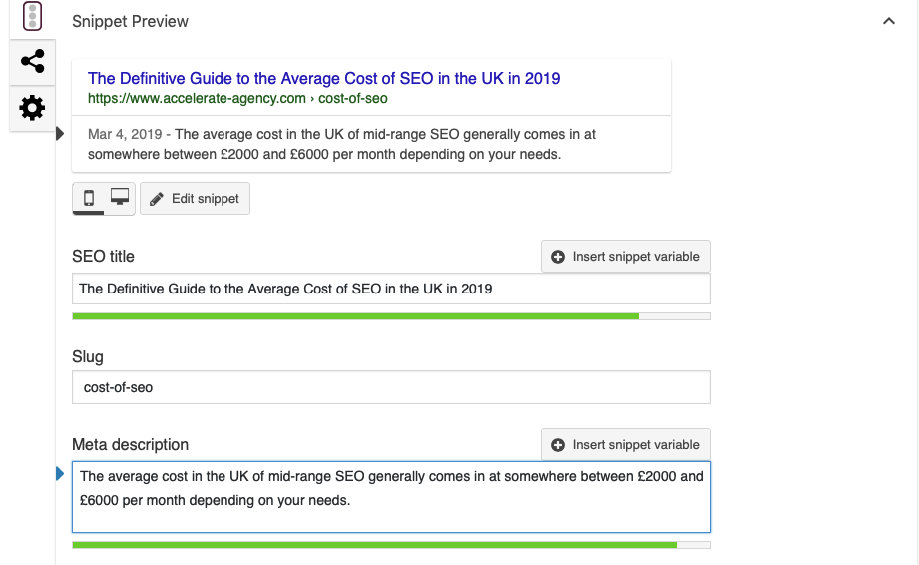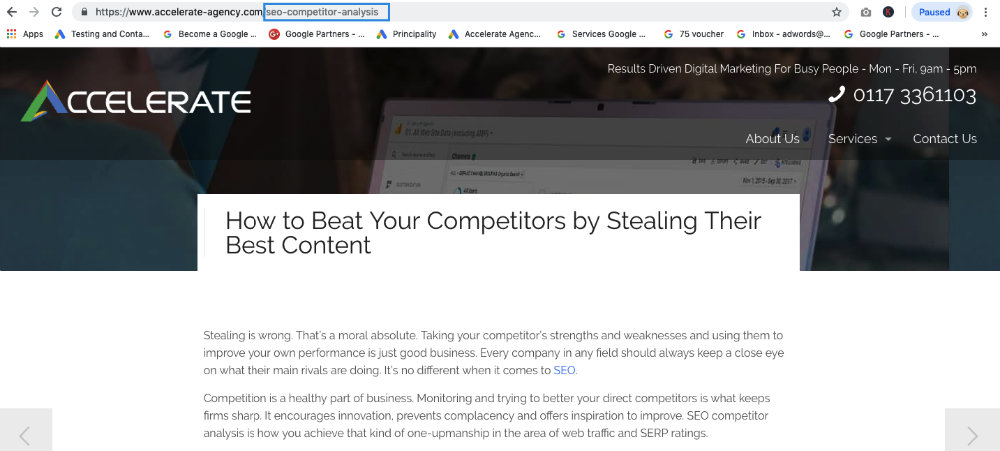SEO is a complex process. There are an almost endless number of techniques, strategies and theories related to it.
Plenty of online real estate has been devoted to explaining and discussing them. Most people don’t have the time to read all that.
So I decided to put together this bite-sized guide. We’re going to cover ten top tips on SEO for beginners and how improve SEO performance. These are strategies that we implement at Accelerate Agency, a company that I co-founded. If you’re interested in improving your results, without the costs associated with SEO, this guide will be for you.
The guide will provide a brief explanation of each tip so you should end up with plenty of great ideas for driving more traffic to your blog or vaulting your pages up SERPs. This is useful for Small Business SEO to complex search engine optimization

1. Improving Page Speed
Site speed has been a ranking factor for Google algorithms since 2010. Slow loading pages can undo all the SEO good that high quality content or great design of those pages might deliver.
What’s more, load time is also crucial to user experience. Data from Kissmetrics suggests that 40% of people will abandon a website that takes more than three seconds to load. That’s how important page speed is to real web users.
There are many ways to look at boosting your site’s page speed. If you use a CMS software such as WordPress, you can remove unnecessary widgets and deactivate non-essential plugins. Additionally, you could consider using a Content Delivery Network (CDN). Optimising images or introducing Accelerated Mobile Pages (AMPs) are also good places to start.
Accelerated Mobile Pages (AMP) are basically stripped down HTML web pages. They are designed specifically to be fast loading on mobile devices. Google love sites that deliver good user experience. AMPs help ensure that user experience is consistent across different devices.
AMPs, as a result, are something that the search engine are pushing hard. In fact, Google are a major supporter of the AMP Project.

2. Sharpening Up Metadata
Metadata is one of those much-discussed elements of SEO. We don’t have the time here to go into the subject in exhaustive detail. This analysis from Yoast is a great resource if you’re looking for a long read.
What we’re going to do is focus on the two most fundamental elements of metadata. Page titles and meta descriptions. Titles and meta descriptions are two key pieces of information provided both to Google and to searchers.
Your titles and meta descriptions should also really speak to searchers. They are what potential site visitors see on a Google SERP, so must induce them to click on your page. Making sure your titles and meta description have the correct length is therefore essential.
3. Linking to Relevant Websites
Linking out from content to other websites is a contentious issue. Some SEO pros and webmasters think it’s best avoided. They see it as going against the fundamental idea of trying to outperform your competitors. An external link, in their mind, is an invitation for a visitor to your site to head elsewhere.
As long as you are linking to content that does not overlap with the keywords you are targeting it’s not an issue. Links to high authority sites that are relevant to a page’s topic are useful to users. They help deliver extra information and demonstrate a high level of trust to Google.
Linking to relevant websites can also have a more practical positive effect on SEO performance. If they’re in your niche – which they should be to make the link relevant – they may then link to some of your content in the future. This also creates a good opportunity to network with influencers and stakeholders in your vertical.

4. Utilise Long Tail Keywords
Most site owners know the importance of keywords to SEO performance. What they might not know is the benefit that can come from properly utilising long tail keywords. Those are very specific keywords, which people are likely to type into a search box.
Long tail keywords makeup over 70% of all web searches. These diverse search terms generally have a low search volume, but are easier to rank for.
The best content marketing strategies incorporate long tail keywords. Those keywords provide real insight into the information which searchers want. Understanding the long tail keywords related to your niche lets you create truly useful content. It also helps you to avoid duplicating content as each post or article you create will have an individual focus.
5. Work on Your Backlink Profile
Inbound links to your site are fundamental to SEO performance. Your site’s backlink profile is something you should always be looking to improve. That means both looking to increase the number of links you have and ensuring that those links are high quality.
What you want are links from sites and pages that have high authority, and are relevant to your content. If you can create this kind of backlink profile you’ll improve your SERP rankings and avoid any risk of Google penalties. Ensuring you have the right backlink profile also involves disavowing backlinks from spammy sites, which you will inevitably collect.
Creating great content that other sites want to link to, combined with networking, is the best way to gain useful links. That takes lots of time and effort, but is definitely worth it. There are other avenues to explore which can deliver results a little quicker. Providing guest posts to relevant industry blogs is one example. Capitalising on broken links from competitors’ pages is another.
6. Use Internal Linking
When SEO pros use the phrase ‘link building’, they usually mean getting external links to a site. Just like we were talking about above. Internal links and having a good internal linking strategy is also key to a site’s SEO.
You need to constantly evaluate and improve your internal linking strategy. Having the right internal links provides Google with vital information. It tells the search engine the relevance of your pages, the relationship between them and their value.
Mistakes with your internal linking strategy can cause huge problems. Broken links will damage your site’s crawlability for Google bots. Having too many links, meanwhile, can make any page seem spammy and of low quality. SEMrush have put together a great study to help you really get to grips with your internal linking.

7. Optimise Page URLs
The URL structure of content on your site is something that can be easy to overlook. A succinct url structure focused around a relevant search term is easier for users and robots to understand. Reviewing and optimizing URLs is straightforward but can be really useful to SEO performance.
A good rule of thumb is to use the key phrase you are targeting and avoid including the date, numbers or other characters. Also avoid using underscores between words and use hyphens instead. It’s easy to optimize your url structure with WordPress and most Content Management Systems.

8. SEO Your Images
Images are important to SEO. They break up text, and make content easier to read and engage with. Unsurprisingly Google recognizes this, which is why they have a very real impact on organic traffic to your site.
Plus there is an entire section on Google devoted to image searches.
You should optimize your image names, and include the main keyword you want a page to rank for. Any captions used should also feature that or a related keyword. You can see why this is important when you look at a cache version of a page (the same version a Google robot sees).
When naming your images, don’t make the mistake of keyword stuffing. Artificially ramming keywords into image names and captions is a no-no. Here is a great article on image SEO tips.
9. Don’t Neglect Social Media
The exact effect of social media on SEO is hotly contested. Most SEO pros do believe that social media does still have an impact on ranking performance, but the exact impact is hotly contested.
There have been plenty of case studies that have delivered evidence to prove there is an impact. The sites of companies which achieve lots of positive social signals routinely achieve better SERP rankings. That’s enough to suggest that you shouldn’t neglect social media. Especially given that a good social media presence will also have its own rewards. Open Graph helps you optimize your social media presence by giving you control over your snippets when URLs are shared on social media.
10. Analyse and Adapt
SEO is not a static process. You can’t just spend a week or even a month on SEO and then forget about it. You need to continually keep track of your SEO efforts. It’s the only way to see what’s working and what’s not. There are loads of different analytics options available to track your SEO performance.
The Google Search Console is the most obvious and the best place to start. Using it will let you keep an eye on traffic, bounce rate, links and all kinds of other useful information. That way, you can tweak, update and change your SEO strategy to stay ahead of the curve. Things that aren’t working can be abandoned and new techniques tested. Here is a useful guide to analyse search performance.
If you have any questions about the content I covered in this post let me know in the comments below.
Save on Pinterest for later:

Comments are closed.